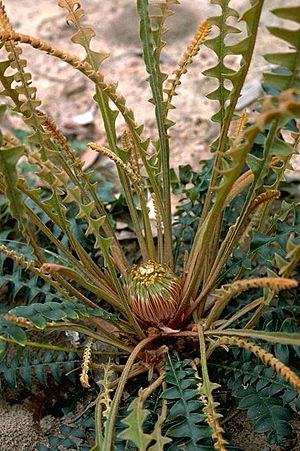Banksia calophylla facts for kids
Quick facts for kids Banksia calophylla |
|
|---|---|
 |
|
| Scientific classification | |
| Genus: |
Banksia
|
| Species: |
calophylla
|
| Synonyms | |
|
|
The Banksia calophylla is a special kind of shrub. It only grows in Western Australia, meaning it's endemic there. This plant has a cool trick: its stem grows underground, which helps it survive bushfires! Its leaves are shaped like feathers and have soft, woolly hairs underneath. When it blooms, you'll see groups of 30 to 45 yellowish-brown flowers. These flowers are surrounded by small, hairy leaf-like parts called bracts.
What Does Banksia calophylla Look Like?
The Banksia calophylla is a shrub with a special stem that grows underground. This helps it survive fires. Its leaves are shaped like feathers, which botanists call pinnatifid. The underside of these leaves feels soft because it's covered in woolly hairs.
The leaves are quite long, about 150 to 350 millimeters (6 to 14 inches) in length. They are also 20 to 55 millimeters (0.8 to 2.2 inches) wide. Each leaf sits on a hairy stalk called a petiole, which is about 20 to 40 millimeters long. Along the sides of the leaves, there are 15 to 20 triangle-shaped parts, or lobes. Each lobe can be up to 28 millimeters long.
The flowers of this banksia grow in groups, called "heads," at the very ends of the stems. Each flower head has between 30 and 45 flowers. Around these flower heads, you'll find hairy, egg-shaped or spear-shaped bracts. These bracts are like small, modified leaves and are about 10 to 15 millimeters long.
The flowers themselves have a pleasant scent and are yellowish-brown. The main part of the flower, called the perianth, is about 40 to 41 millimeters long. Inside, there's a cream-coloured part called the pistil, which is about 38 to 39 millimeters long.
How Did This Banksia Get Its Name?
This plant was first officially described in 1830 by a botanist named Robert Brown. He gave it the name Dryandra calophylla. He published his description in a special book called the supplement to his earlier work, Prodromus Florae Novae Hollandiae et Insulae Van Diemen.
The second part of its name, calophylla, comes from ancient Greek words. "Calo" means "beautiful," and "phylla" means "leaf." So, its name basically means "beautiful leaf."
Later, in 2007, two other scientists, Austin Mast and Kevin Thiele, made a big change. They decided that all plants previously known as Dryandra should actually be part of the Banksia group. That's why its name changed from Dryandra calophylla to Banksia calophylla.
Where Does Banksia calophylla Grow?
This special banksia plant lives in the wild in Western Australia. You can find it growing in areas with shrubs and woodlands. It grows in a region between the towns of Tenterden, Albany, and Wellstead. These areas are part of what scientists call the Esperance Plains and Jarrah Forest biogeographic regions.

